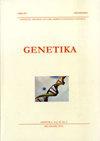优良小麦种质对巴基斯坦西北部小麦生产威胁赤霉病的抗性评估
4区 农林科学
Q3 Agricultural and Biological Sciences
引用次数: 0
摘要
小麦赤霉病(Fusarium head blight, FHB)是由小麦赤霉病引起的一种严重影响小麦产量和品质的疫病。在巴基斯坦,由于春季有利的环境条件,口蹄疫可能对小麦造成重大损失。最近,我们在巴基斯坦西北部斯瓦特河沿岸的麦田中发现了FHB,发病率为34-84%。因此,利用FHB -1、2和3特异性分子标记,对巴基斯坦的优良小麦品种和候选品系以及外源近等基因品系进行了FHB抗性筛选。此外,还对所有种质进行了2NS易位筛选,这些易位来自于含有FHB等多种疾病抗性基因簇的小麦脑室段。在巴基斯坦小麦品种中,Marvi-2000显示出Fhb-2和fhb - 3特异条带;Saleem-2000显示存在Fhb-1和2特定波段。在候选品系中,L-112、L-105、L-106、L-103和L-129扩增出Fhb-1和fhb - 2特异性条带,而L-111单独扩增出Fhb-1和Fhb-3特异性条带。此外,利用2-NS特异性标记VENTRIUP和LN2在美国堪萨斯州立大学获得的2NS近等基因系(NILs)中证实了2NS易位,但在巴基斯坦品种和候选品系中未发现2-NS易位。总之,没有一个巴基斯坦品种或候选品系完全具有所有的FHB抗性来源;然而,令人惊讶的是,一个外来的NIL (Yaccora-Rojo-2NS)不仅表现出2NS易位,而且还表现出Fhb-1、2和3抗性基因。本文章由计算机程序翻译,如有差异,请以英文原文为准。
Assessment of elite wheat germplasm for resistance to Fusarium head blight -a threat to wheat production in north-west Pakistan
Fusarium head blight (FHB), caused by Fusarium graminearum, affects both quality and quantity of wheat produce. In Pakistan, due to favorable environmental conditions during spring, FHB can cause significant losses to wheat. Recently, we observed FHB in wheat fields, having 34-84% incidence, along river Swat, Northwest Pakistan. Therefore, elite wheat cultivars and candidate lines in Pakistan as well as exotic-near isogenic lines were screened for FHB resistance using molecular markers, specific for Fhb-1, 2 and 3. Furthermore, all the germplasm was screened for 2NS Translocation - from Triticum ventricosum segment containing cluster of resistance genes for many diseases including FHB. Among Pakistani wheat varieties, Marvi-2000 showed presence of Fhb-2 and 3 specific bands while wheat cv. Saleem-2000 displayed presence of Fhb-1 and 2 specific bands. However, among the candidate lines, L-112, L-105, L-106, L-103 and L-129 exhibited Fhb-1 and 2 specific bands while L-111 alone amplified bands specific to Fhb-1 and Fhb-3. Moreover, 2NS translocation was validated in 2NS near isogenic lines (NILs) obtained from Kansas State University using 2-NS specific marker VENTRIUP and LN2, however, no 2-NS translocation was found in Pakistani varieties as well as candidate lines. In conclusion, none of the Pakistani varieties or candidate lines possessed all sources of FHB resistance in altogether; however, one aliens NIL (Yaccora-Rojo-2NS) surprisingly not only exhibited 2NS translocation but also Fhb-1, 2 and 3 resistant genes.
求助全文
通过发布文献求助,成功后即可免费获取论文全文。
去求助
来源期刊

Genetika-Belgrade
AGRONOMY-GENETICS & HEREDITY
CiteScore
1.80
自引率
0.00%
发文量
1
审稿时长
6-12 weeks
期刊介绍:
The GENETIKA is dedicated to genetic studies of all organisms including genetics of microorganisms, plant genetics, animal genetics, human genetics, molecular genetics, genomics, functional genomics, plant and animal breeding, population and evolutionary genetics, mutagenesis and genotoxicology and biotechnology.
 求助内容:
求助内容: 应助结果提醒方式:
应助结果提醒方式:


